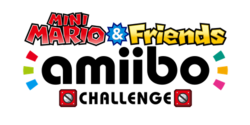Gameplay
The title's main gameplay is based on the Mario vs. Donkey Kong series. [2] [3] [4] There is only a single-player mode. [5] Players use a stylus to manipulate the level layout, allowing miniature Mario series characters to survive or achieve goals. Objects such as girders or trampolines can be moved, allowing characters to travel along their intended path. Example characters include Mario, Diddy Kong, Luigi, Rosalina, Toad, Bowser, Princess Peach, Bowser Jr., Donkey Kong, and Yoshi, all sporting a unique power. [3] Obstacles are included such as mine carts and ghost Boos. [5]
Amiibo requirement
There are eleven mini playable characters. [5] The game requires Nintendo's Amiibo figurine lineup in order to play, and Amiibo of certain Mario series characters unlock miniature versions of those characters with special abilities. [2] Only Amiibo figures can be used to play the game, not Amiibo cards. Amiibo figurines produced by a third-party also work. [4] If the player has a non-Mario series Amiibo figure, the game will put in Mini Spek [4] instead of the Amiibo figure the player puts on the Wii U GamePad, and the NFC Reader/Writer connected to Nintendo 3DS, Nintendo 3DS XL or Nintendo 2DS, or the New Nintendo 3DS, New Nintendo 3DS XL or New Nintendo 2DS XL. The Mini Spek is a character that resembles a blue wind-up block that has no special abilities. Mini Spek can't access Amiibo doors, but can undergo a basic set of levels. [1]
Characters from the Mario canon work, and when unlocked in the game, unlocks a mini version of the Amiibo and its special move. Examples include six Yoshi figurines, from both Super Smash Bros. and Yoshi's Woolly World . The six available Mario figurines result in a Mini Mario character with wall jump as a special ability. With two figurines that work, Mini Luigi has high jump as an ability, and Mini Peach from two figurines has floating jump. There are two figurines for Mini Bowser, who has the special ability Bowser Bomb. Mini Rosalina, Mini Donkey Kong and Mini Diddy Kong can also be unlocked with their respective Super Smash Bros. and Super Mario Amiibo figures. There are only single Amiibo figurines to unlock Mini Toad and Mini Bowser Jr. [1]
Stages
There are over 50 levels total. [5] The map has several secret unlockable levels, as well as additional fringe zones for each supported character. In addition to the main missions, there are also character-themed worlds with four stages each, such as Luigi's Mansion and Bowser's Castle. [3]
With the basic character, there are 12 stages in total. [4] With a Mario-themed character, more stages unlock, and 10 of the 12 core stages have an alternate exit that in turn have four special stages for that specific character. [4] There are also two collectible 'amiibo cards' that only specific characters can reach. This means that for a player to achieve 100% completion, they need an amiibo for 10 Mario universe characters, and need to play each core level three times. [4]
This page is based on this
Wikipedia article Text is available under the
CC BY-SA 4.0 license; additional terms may apply.
Images, videos and audio are available under their respective licenses.

